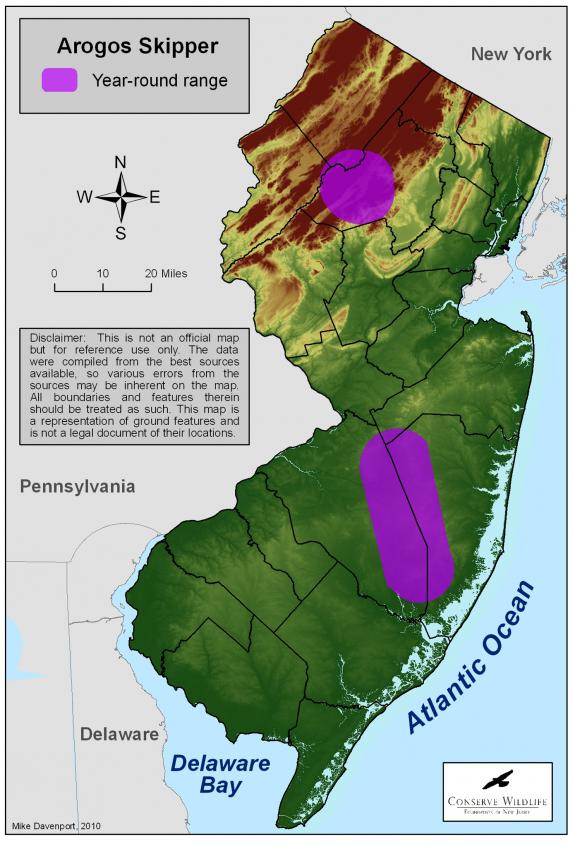Atrytone arogos arogos
Type: invertebrate
Status: endangered
Species Guide
Arogos skipper
Atrytone arogos arogos
Species Type: invertebrate
Conservation Status: endangered
Identification
Arogos skippers range in length from 1.3-1.4 in. (35-41 mm) and look very similar to the abundant Delaware skipper (Anatrytone logan). Both species a light orange with black wing margins on the upper surface. The margins are thicker on the arogos. The arogos also have a white fringe on the underside of its hindwing and an overall deeper orange color on the undersuface of the wings.

Distribution & Habitat
The arogos skipper is very sparsely distributed throughout its range. It is largely restricted to a few states along the Atlantic Coast. Population strongholds for the species can be found in New Jersey, Florida, and North Carolina. The New Jersey Pinelands may hold the largest single population of arogos skippers in the world.
Habitat requirements for this species differ dramatically throughout its range. In the New Jersey Pinelands, arogos skippers tend to inhabitat post-burn wetland habitats dominated by Pine Barrens reed grass (Calamovilfa brevipilis), which serves as its host plant (Schweitzer 1992). In northern New Jersey, they inhabit dry grasslands that are dominated by Little bluestem (Schizachyrium scoparius), its host plant.
Diet
Caterpillars feed on Little bluestem in Northern New Jersey and in the Pinelands region they feed on Pine Barrens reed grass. Adults feed on nectar from knapweeds (Centaurea spp.), milkweeds (Asclepias spp.), thistles (Cirsium spp.), and blazing-stars (Liatris spp.).
Life Cycle
The flight period for this species in New Jersey is brief (only from mid to late July into August). In Northern New Jersey, arogos fly during the first three weeks of July. Adults can be seen in flight during late morning to early afternoon, on sunny days, when temperatures are below 80oF. In the Pinelands, adults fly during late July/early August. They are easily flushed from nectar producing plants in the late afternoon/early evening when temperatures are below 90oF. The larvae stage lasts from late July to mid-June during the following year. The egg and pupae stages last from one to two weeks long.
Current Threats, Status, and Conservation
This species is in serious jeopardy of becoming extirpated from large portions of its range. They were listed as endangered in 2001 and are protected by the New Jersey Endangered Species Conservation Act. The Pinelands reed-grass feeding arogos contains four of the (five total) largest populations in its entire range that specifically occupy this habitat ecotype. Habitat loss and changes in natural fire regimes are the two major threats to this species. In the Pinelands, reed-grass becomes established after wildfires. Without natural fire events, these natural grasslands have become extremely rare within the Pinelands and the arogos has suffered. Development and proper land management in Northern New Jersey threaten arogos skippers. Many grasslands are left to succeed into forests and are lost to strip malls and housing developments, mostly because they are the easiest land to develop. Additional survey and natural history research are needed to fully understand the range and biology of the arogos skipper. Research should also concentrate on identifying the effects of different land management techniques.
References
Schweitzer, D. F. 1992. Element ecology and life history. In The Comprehensive Report of Atrytone arogos arogos. NatureServe: An online encyclopedia of life. 2001. Version 1.5. Arlington, Virginia, USA: Association for Biodiversity Information.
Text derived from the book, Endangered and Threatened Wildlife of New Jersey. 2003. Originally written by Dave M. Golden & Jason Tesauro. Originally edited by B.E. Beans & L. Niles. Edited and updated in 2010 by Ben Wurst.
Scientific Classification
- Kingdom: Animalia
- Phylum: Arthropoda
- Class: Insecta
- Order: Lepidoptera
- Family: Hesperiidae
- Genus: Atrytone
- Species: A. arogos